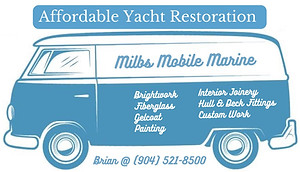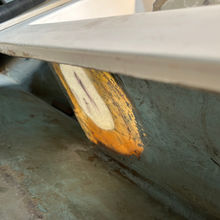
9610 Commonwealth Ave., Jacksonville, FL 32220
Interior Fiberglass Repair Pt. 2 (12-28-24)
Dec 28, 2024
Back on Biscuit today, I began by removing the peel ply and my usual water-wash process to remove any amine blush that formed through the epoxy curing process that was not covered with peel ply. With the perfunctory epoxy task completed, I grabbed a few 80-grit sanding disks and worked to soften the edges on the back side of the repair surfaces, as well as the areas that the peel ply missed. Generally, I sanded and roughed up the surfaces to accept more epoxy and glass. The peel ply is a huge time-saver, but I guess I just have gotten used to sanding before further lamination efforts. There was also an issue with the fiberglass "backing plate" on the starboard repair area, a bulge to the lower portion of the repair. I was a bit worried about this area on the layup day, and even placed a plastic-covered piece of cardboard across the lower portion to ensure the glass cured in the proper plane. But despite good intentions, I discovered the bulge when hand-sanding with the 80-grit paper.
I placed a straightedge across the starboard repair surface - bridging the old glass, forward to aft. I moved this straightedge up and down across the repair area to map where the bulge began and where it fell back into the proper plane. I marked the end of the bulge with a sharpie and then grabbed an oscillating tool with a carbide blade. I made quick work of removing the bulge - less of a battle and more of a capitulation. I continued to hand-sand the area to prep for another layer of backing cloth, and to fill the void at the intersection of the hull and floor and vertical surfaces of the fiberglass liner.
A quick template later, I was removing the additional backing layer and glass it into place, but just prior to this, I mixed a pot of thickened epoxy (404 high-density and 406 colloidal silica) and filled the void beneath the liner and hull. I finished the backside with a layer of peel ply. While the slow cure hardener was in the open window, I applied a layer of 6oz fiberglass cloth the frontside of the starboard repair area, and completed it with peel ply. The gelcoat application on the interior fiberglass liner was applied fairly thin, so my intention was to build the back surfaces up and cosmetically finish the front portion of each repair area.
The port side repair area went a lot easier, as I just focused on the front surface: wet it out / apply thickened epoxy to fill voids, apply the 6oz cloth, and then finish with peel ply.
The larger task for the day was to start the repair on the area I am calling the "engine pan". I had prepared the surface during the grinding phase, so now I vacuumed the surface and solvent-washed it a few times to ensure a clean surface. The process was, again, like the others: template, cut layers of new cloth, wet-out, apply new fiberglass and then finish with peel ply. in this instance, I did begin with wetting-out, but chose to apply a layer of filler (West Systems' 404 + 406) to fill small voids. Also, with the significant voids and cracks in the engine pan corners, I began with two layers of 6oz cloth to bridge the voids and create a surface to take filler - necessary for this specific repair. As the 6oz cloth came to a soft cure, I mixed and applied the filler consisting of 404 high-density and 406 colloidal silica, and applied it to the harsher shallows knowing the 1708 would not take the extreme curves that the 6oz took. With a small squeegee, and assisting with a finger or two, I shaped the filler such to eliminate/reduce the shallow spots, and then applied the wet-out 1708 biaxial cloth. I finished the day with applying peel ply to the engine pan. Next steps may be to apply additional layers of cloth and will certainly be to apply fairing compound to shape the final faired surface.
Total Hrs: 5.25






